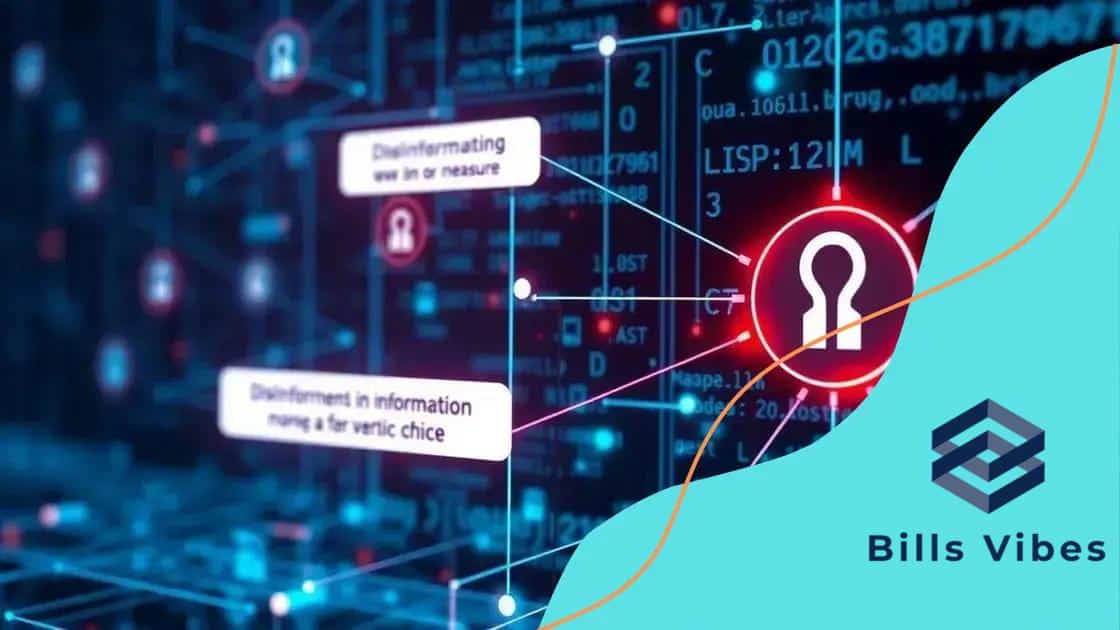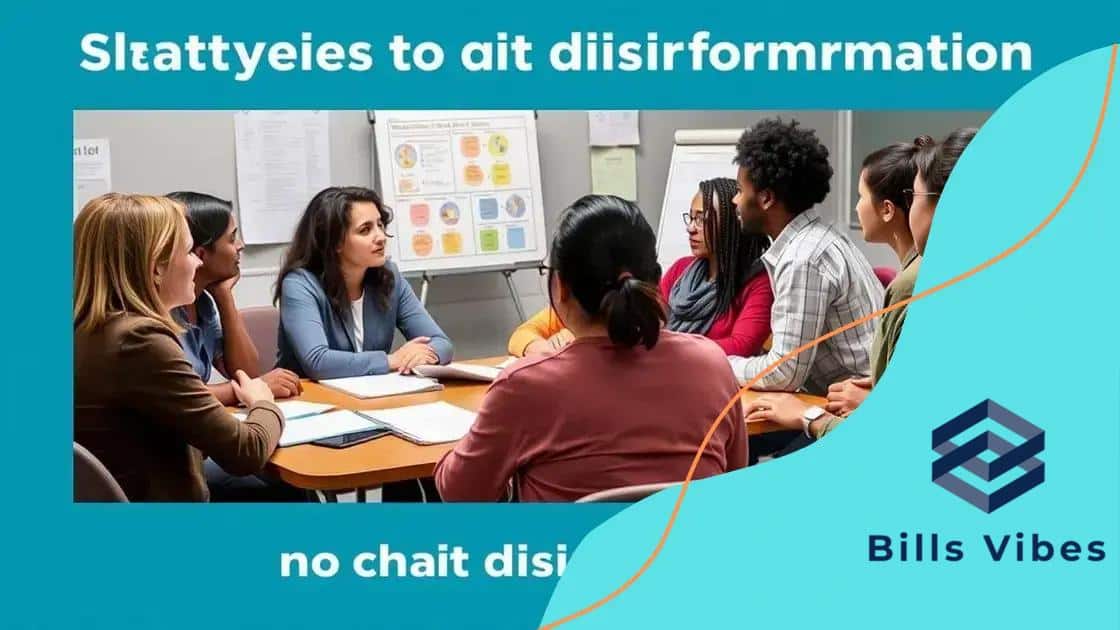Global disinformation control measures: what you need to know

Global disinformation control measures encompass strategies that leverage technology, legislation, and public awareness to combat the intentional spread of false information and enhance media literacy across communities.
Global disinformation control measures are becoming increasingly crucial in our digital age. How do these measures impact our access to information? Let’s dive into their significance.
Understanding global disinformation
Understanding global disinformation is essential in today’s connected world. As false information spreads rapidly, recognizing its impact can help us navigate challenges.
What is Global Disinformation?
Global disinformation refers to the deliberate spread of false or misleading information across various platforms. It can influence public opinion, disrupt social harmony, and even affect elections. Knowing how it operates can empower individuals.
Key Characteristics of Disinformation
- Intentionally misleading: It seeks to deceive readers.
- Wide reach: Disinformation can spread quickly through social media.
- Emotion-driven: Often targets emotions to manipulate responses.
By understanding these traits, we can better identify and combat disinformation. Various factors contribute to this phenomenon. For instance, the rise of social media has made it easier for misinformation to circulate.
Many people share information without verifying its accuracy. This can lead to the rapid spread of false narratives that mislead the public. Consequently, recognizing what drives these behaviors is crucial.
The Role of Technology
Technology plays a significant role in global disinformation. Algorithms prioritize content that generates engagement, often promoting sensationalized information. It’s vital to be aware of how these mechanisms work to avoid being unintentionally misled.
We can combat misinformation through critical thinking and verification of sources. Engaging in discussions about media literacy can also empower others to think critically. Applying these principles can help reduce the spread of disinformation within our communities.
Examples of disinformation campaigns
Examples of disinformation campaigns illustrate the various tactics used to spread false information. These campaigns can greatly influence public perception and decision-making.
Notable Disinformation Campaigns
One significant example is the 2016 U.S. presidential election. Various groups used social media to disseminate fake news aimed at swaying voter opinions. These tactics showed how disinformation could infiltrate public discourse effectively.
Common Techniques in Disinformation
- Creating fake accounts to amplify messages.
- Spreading sensational or emotionally charged stories.
- Using memes to simplify complex issues.
In another case, during the COVID-19 pandemic, numerous false claims circulated about the virus’s origins and treatments. This led to confusion and fear, highlighting how dangerous disinformation campaigns can be in times of crisis.
Additionally, campaigns targeting public health often exploit people’s fear. Misinformation about vaccines has become widespread, causing vaccine hesitancy among communities. Understanding these examples can help people recognize the signs of disinformation in their feeds.
Understanding Motivation Behind Campaigns
Different motivations drive disinformation campaigns. Some aim to create political chaos, while others focus on profit through advertisement clicks. By identifying these motives, individuals can better guard themselves against falling victim to propaganda.
Awareness of these examples emphasizes the necessity of critically evaluating the information we consume. Engaging in community discussions about these issues can empower others to recognize and combat disinformation.
Strategies for individuals and organizations

Strategies for individuals and organizations are key to combating global disinformation. Knowing how to identify and respond to false information can significantly reduce its impact.
Individual Strategies
One effective strategy is to enhance your media literacy. Learning how to evaluate sources critically helps you distinguish between reliable and unreliable information. Developing a healthy skepticism regarding sensational headlines is essential.
- Fact-check information before sharing it.
- Follow reputable news organizations.
- Engage with diverse perspectives to challenge your views.
Moreover, individuals should be aware of their own biases. This awareness can prevent them from accepting false narratives that align with their beliefs. Networking with others can also strengthen strategies to identify and discuss misinformation.
Organizational Strategies
Organizations play a vital role in addressing disinformation. They can establish clear guidelines for sharing information internally and externally. Providing training sessions on media literacy can empower employees to recognize misinformation.
Another effective approach is to collaborate with fact-checking organizations. This partnership can provide access to tools and resources that help combat false information. Regular communication with stakeholders about disinformation trends can also enhance resilience.
Ultimately, creating an open culture within organizations encourages discussions about disinformation. Such environments allow employees to feel comfortable sharing concerns and seeking clarification on questionable content.
Legislative frameworks for control
Legislative frameworks for control play a crucial role in managing global disinformation. Laws and regulations can help ensure that accurate information is shared, while also holding accountable those who spread falsehoods.
Understanding Current Legislation
Several countries have adopted laws aimed at combating disinformation. These laws focus on increasing transparency in political advertising and holding social media platforms responsible for content shared on their sites. For instance, in the European Union, the Digital Services Act aims to regulate online platforms and reduce harmful content.
Key Legislative Approaches
- Defining disinformation clearly in legal terms.
- Requiring platforms to disclose sources of funding for political ads.
- Establishing penalties for spreading false information intentionally.
Additionally, some regions have introduced laws that require social media companies to act more responsibly. This can involve promoting fact-checking services or labeling content that may be misleading. Understanding these frameworks allows individuals and organizations to advocate for fair practices.
Legislative measures are only part of the solution. Collaboration between governments, tech companies, and civil society is essential. These stakeholders must work together to develop comprehensive strategies that adapt to changing tactics used by those spreading disinformation.
Challenges in Implementation
Despite the availability of frameworks, challenges arise in enforcement. Identifying what constitutes disinformation can be complex, and not all countries may have the resources for effective monitoring. Balancing free speech with the need to control false information is also a delicate task that requires consideration of various factors.
By staying informed about these legislative efforts, communities can play an active role in promoting accountability and integrity in information sharing. Engaging with policymakers and supporting initiatives that aim to combat disinformation can lead to positive changes.
The future of disinformation management
The future of disinformation management will be shaped by technology, policy, and public awareness. As disinformation continues to evolve, strategies must also adapt to address new challenges.
Technological Innovations
Emerging technologies, like artificial intelligence, will play a significant role in identifying and combating false information. AI can help monitor online content, flagging potential disinformation before it spreads widely. It’s crucial for tech companies to invest in tools that enhance critical analysis of information.
Policy Developments
Governments worldwide are expected to implement more stringent regulations regarding disinformation. This could include clear definitions of what constitutes disinformation and the consequences for spreading it. Engaging with stakeholders, including tech companies and civil society, will be essential to create effective policies.
- Collaboration between governments and tech platforms.
- Regular updates to legislation to keep pace with changes.
- Increased funding for media literacy initiatives.
Improving media literacy is vital for future success. As people become more skilled at identifying credible sources, the impact of disinformation can be reduced. Educational programs should focus on teaching critical thinking and fact-checking skills.
Additionally, public awareness campaigns can inform citizens about the risks of disinformation. Making people more aware of the tactics used can help them resist manipulation. Organizations can also play a role by promoting transparency in communication.
Global Collaboration
Future management of disinformation will require a global effort. Countries must work together to share information about disinformation trends and develop countermeasures. By building international coalitions, it will be easier to implement standards for handling false information.
Ultimately, everyone has a role to play in the future of disinformation management. By staying informed and proactive, individuals and organizations can contribute to a healthier information ecosystem.
FAQ – Frequently Asked Questions about Global Disinformation Control Measures
What is global disinformation?
Global disinformation refers to the intentional spread of false information across various platforms, impacting public opinion and decision-making.
How can individuals combat disinformation?
Individuals can combat disinformation by enhancing their media literacy, critically evaluating sources, and verifying information before sharing.
What role do governments play in controlling disinformation?
Governments can establish laws and regulations to hold platforms accountable and promote transparency in information sharing.
Why is media literacy important in disinformation management?
Media literacy is crucial as it empowers individuals to recognize credible information, helping reduce the impact of misleading narratives.






